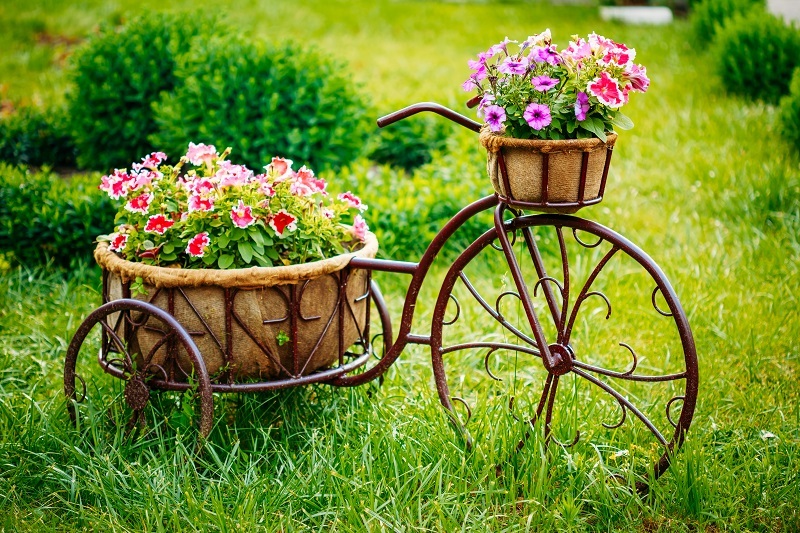Achieving Beautiful Blooms with Hydrangeas
Posted on 17/08/2025
Achieving Beautiful Blooms with Hydrangeas: The Ultimate Guide
Hydrangeas are cherished by gardeners and flower enthusiasts for their spectacular blooms, vibrant colors, and lush foliage. Whether you're a novice gardener or an experienced horticulturist, achieving beautiful hydrangea blooms can be a rewarding pursuit that transforms any landscape into a captivating oasis. In this comprehensive guide, you'll discover the best practices, tips, and secrets for encouraging healthy growth and abundant blossoms on your hydrangea plants.

Understanding Hydrangea Varieties
Before you dive into the specifics of hydrangea care, it's essential to recognize that not all hydrangeas are the same. Each variety has unique blooming habits, color preferences, and growth requirements.
Main Types of Hydrangeas
- Bigleaf Hydrangea (Hydrangea macrophylla) - Known for their large, colorful mophead or lacecap blooms, these are common in residential gardens.
- Panicled Hydrangea (Hydrangea paniculata) - Famous for cone-shaped flowers, they tolerate sun better than other varieties.
- Smooth Hydrangea (Hydrangea arborescens) - These produce round, white or greenish blooms and are prized for their hardiness.
- Oakleaf Hydrangea (Hydrangea quercifolia) - Noted for oak-shaped leaves and white-to-pink panicles, ideal for woodland settings.
- Climbing Hydrangea (Hydrangea petiolaris) - Unique for their climbing habit, they display white flowers and thrive on walls or trellises.
Identifying your hydrangea type helps customize care for the most stunning blossoms.
Choosing the Right Location for Hydrangeas
Hydrangeas might appear low-maintenance, but location makes a significant difference for delivering those breathtaking blooms.
Optimal Sunlight Requirements
- Bigleaf and Oakleaf Hydrangeas: Prefer morning sun and afternoon shade. Excessive shade can reduce blooming.
- Panicled and Smooth Hydrangeas: Can tolerate full sun but flourish best with at least 4-6 hours of sunlight daily.
- Climbing Hydrangeas: Thrive in partial shade and are great for North or East walls.
Soil Conditions for Blooms
- Well-draining, loamy soil is best. Hydrangeas don't like "wet feet", so planting on mounds or raised beds helps.
- Incorporating organic matter such as compost improves texture and adds nutrients.
- Hydrangea color (especially in bigleaf varieties) can be adjusted by soil pH:
- Acidic soil (pH below 6.0): Produces blue flowers.
- Neutral to alkaline soil (pH 6.0 and above): Produces pink or red flowers.
Planting Hydrangeas for Maximum Blooms
Proper planting is the first step toward achieving prolific hydrangea flowers.
Steps to Plant Hydrangeas
- Dig a Hole: At least twice as wide as the root ball and just as deep. This encourages strong root growth.
- Loosen the Roots: Gently spread out roots before lowering the plant into the hole.
- Backfill and Water: Mix soil with compost and backfill the hole. Water thoroughly to eliminate air pockets.
- Mulch: Use organic mulch (like bark or pine needles) to retain moisture, suppress weeds, and keep roots cool.
Tip: Space hydrangea plants adequately (3-10 feet apart, depending on variety) to avoid overcrowding, which can hinder bloom performance.
Watering Techniques for Healthy Hydrangea Blooms
One of the keys to luxurious hydrangea flowers is consistent watering. These shrubs need plenty of moisture, especially during hot or dry periods.
- Deep weekly watering: Rather than shallow daily watering, soak the soil at the base of the plant once or twice a week.
- Avoid overhead watering to reduce fungal diseases on leaves and blooms.
- Check soil moisture regularly; hydrangeas wilt quickly if roots are too dry but dislike being waterlogged.
Fertilizing Hydrangeas for Stunning Blooms
Feeding your hydrangeas is crucial for sustaining vibrant, colorful, and abundant hydrangea blossoms.
Best Fertilizers for Hydrangeas
- Balanced slow-release fertilizer (10-10-10 or 12-4-8): Apply in early spring as new growth emerges.
- Add compost or well-rotted manure to the root zone each year.
- For blue flowers, use fertilizer low in phosphorus. For pink or red blooms, choose one high in phosphorus.
Fertilization Schedule
- Fertilize in early spring and again in late spring if growth is sluggish.
- Avoid late summer fertilization; it can encourage lush foliage at the expense of blooms.
Pruning Hydrangeas: Timing and Methods Matter
Knowing when and how to prune is invaluable for achieving amazing hydrangea flowers. Pruning at the wrong time can inadvertently remove next year's buds!
When to Prune
- Bigleaf and Oakleaf Hydrangeas: Bloom on old wood. Prune immediately after flowering, before buds for next year develop.
- Smooth and Panicle Hydrangeas: Bloom on new wood. Prune in late winter or early spring before growth starts.
- Climbing Hydrangeas: Minimal pruning is needed; remove dead or awkward branches as required.
Proper Pruning Techniques
- Use sharp, clean pruning shears to make clean cuts and reduce disease risk.
- Remove dead, diseased, or crossing branches.
- For bushier plants, selectively cut older canes to the ground to encourage new growth.
Adjusting Soil pH for Custom Hydrangea Flower Colors
One of the fascinating features of hydrangeas, especially bigleaf hydrangeas, is their ability to change flower color based on soil pH.
How to Adjust Soil pH
- To achieve bright blue blooms: Lower the pH by adding garden sulfur or aluminum sulfate. Test pH annually.
- For pink to red flowers: Raise the pH by adding lime or dolomitic lime to the soil.
- Consistent amendments may be required. It can take a full season for color changes to appear.
Remember, white hydrangea varieties cannot change color based on soil pH.
Protecting Your Hydrangeas from Pests and Diseases
Healthy hydrangeas are more likely to deliver abundant, gorgeous blossoms. Watch out for these common problems:
Most Common Hydrangea Pests
- Aphids: Cause curled leaves and stunted growth. Use insecticidal soap or strong water spray to remove.
- Spider mites: Thrive in hot, dry weather; leaves may develop stippling or webs.
- Scale insects: Appear as small bumps on stems and leaves. Scrape off or apply horticultural oil.
Preventing Hydrangea Diseases
- Powdery mildew: White, dusty spots on leaves. Improve air flow and avoid overhead watering.
- Leaf spots: Brown or black spots can be managed by removing infected leaves and improving spacing.
- Root rot: Ensure good soil drainage and never let roots sit in soggy soil.
Encouraging Blooms: Secret Tips and Insider Tricks
Sometimes, even after diligent care, hydrangeas may present fewer blooms than expected. Here are some expert tricks to ignite abundant flowering:
- Don't over-fertilize: Too much nitrogen leads to leafy growth, not flowers.
- Protect buds from frost: Late spring frost can damage flower buds on varieties that bloom on old wood. Cover with cloth if frost is forecast.
- Avoid drought stress: Regularly check soil and maintain deep watering, especially during high heat.
- Pinch off faded blooms (deadheading): In some varieties, this encourages new flowers.
Common Mistakes That Impair Hydrangea Flowering
- Improper pruning: Pruning at the wrong time can remove buds destined for next season's flowers.
- Planting in heavy shade: While hydrangeas like some shade, too little sunlight limits flower production.
- Inadequate watering during dry spells: Hydrangeas wilt quickly and respond by aborting blooms or reducing flower size.
- Neglecting soil quality: Poor, compact, or unamended soil leads to subpar flower showings.
Designing Your Garden for Continuous Hydrangea Blooms
With smart planning and variety selection, you can extend your hydrangea blooming season for months of awe-inspiring color.
Stagger Varieties for Season-Long Interest
- Panicled hydrangeas bloom from mid-summer into fall.
- Smooth hydrangeas often flower from late spring into summer.
- Bigleaf and oakleaf hydrangeas add early and ongoing summer color.
- Select companions such as ferns, hostas, or astilbes that thrive in similar conditions and accentuate hydrangeas' beauty.

Hydrangea Bloom FAQs
1. Why are my hydrangeas not blooming?
- Possible causes include improper pruning, insufficient sunlight, late frosts damaging buds, or over-fertilization.
- Evaluate bloom type to determine if blooms form on old or new wood; this affects pruning timing.
2. How do I get more flowers on my hydrangea?
- Provide consistent watering, use appropriate fertilizers, adjust soil pH for bigleaf hydrangeas, and avoid heavy pruning during the bud-setting season.
3. Can hydrangea colors really be changed?
- Yes, for bigleaf hydrangeas. Blue and pink hues are pH dependent, but white hydrangeas remain white regardless of soil condition.
Conclusion: Enjoying the Beauty of Hydrangea Blooms Year After Year
Hydrangeas reward gardeners with show-stopping, colorful blooms when provided with proper light, soil, care, and attention to their unique needs. By understanding your hydrangea variety, perfecting planting techniques, maintaining optimal soil conditions, watering consistently, fertilizing judiciously, and pruning at appropriate times, you set the foundation for years of spectacular floral displays. Remember, a little patience and observant care go a long way in achieving beautiful hydrangea blooms that delight season after season.
Start with these tried-and-true practices, and don't be afraid to experiment with new varieties and companion plantings. With the right approach, your garden will soon be overflowing with inspiring hydrangea blossoms to enjoy, photograph, and share!
Latest Posts
Elevate the birthday mood with the best choice of flowers
Achieving Beautiful Blooms with Hydrangeas
The Art of Making Your Poinsettias Last





